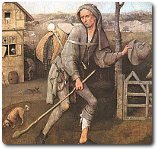Songs of Innocence and Experience Contents
The Little Vagabond - Imagery, symbolism and themes
Imagery and symbolism
 Vagabond – Calling the child a ‘vagabond' was not designed to evoke great sympathy from Blake's contemporaries. Like travellers today, vagabonds would attract all kinds of negative associations. We should consider what the speaker says without the intrusion of sentimental reactions and hear the voice of a child who has been exposed to the harshness of the world and is better acquainted with the rough life of the pub than the church.
Vagabond – Calling the child a ‘vagabond' was not designed to evoke great sympathy from Blake's contemporaries. Like travellers today, vagabonds would attract all kinds of negative associations. We should consider what the speaker says without the intrusion of sentimental reactions and hear the voice of a child who has been exposed to the harshness of the world and is better acquainted with the rough life of the pub than the church.
Ale-house – The ale-house stands for everything which celebrates human community and the goodness of physical life, without prohibition and the exercise of external authority.
Fire – The fire in the poem is metaphorical as well as literal. Its conventional associations are with warmth, light and security, but Blake also associated fire with creativity (as in The Tyger). This links in with Christian teaching, where fire is a symbol of God's Holy Spirit, involved in the creation of the world and in refining believers. The Bible teaches that the church is called not to quench this fire (1 Thessalonians 5:19) but to fan it into flame (2 Timothy 1:6). Blake was critical of established church practice which appeared to ignore this.
Church – The Church stands not only for the building and Sunday services. It also implies a repressive system which denies pleasure in life and projects God as a life-denying rule-giver. This is represented, too, by Dame Lurch. In Blake's time, many poor children had very basic education at ‘dame schools' that seem here to be closely associated with the values of the Church, repressing children and denying them freedom and physical pleasure.
[Child] – Behind the other imagery of this poem lies the image of the child. To Blake, the child was an image of freedom and of the creative imagination. The child represents all that is lively, free and creative. Here, children are in protest against a system that would destroy their freedom and exploit them.
Reconciliation – In stanza four, Blake echoes the imagery of a famous parable taught by Jesus in the New Testament, that of the Prodigal Son (see Luke 15:11-32, particularly vv.20-24). This is a powerful image of reconciliation, but the biblical account had the rebellious son requesting forgiveness for his wrongdoing, which was readily given with the father's embrace. The poem does not seem to envisage any such request for forgiveness by Satan. However, it reflects Blake's belief in the necessity of combining the contraries of creation.
Investigating imagery and symbolism
- Do you find the ale-house an adequate symbol of the celebration of human community and the goodness of the body?
- Look at Hogarth's contemporary engraving, Gin Lane, online
- What light does it shed on Blake's world?
- How satisfactory do you find the idea of good and evil being reconciled in stanza four?
Themes
The distortion of Christian belief about the future life
Blake attacks the approach of some forms of contemporary Christianity. This taught people to accept present suffering and injustice because of the promise of bliss and the absence of all suffering in the next world. In this poem, we see it in the contrast between the human warmth and hospitality of the ale-house and the grim denial of pleasure enforced by the Church which looks to reward in the future.
Authority and the suppression of children
In Blake's work, adults are often perceived as inhibiting and repressing the children in their care. Their own fears and shame are communicated to the next generation through the desire to ‘protect' children from their desires. According to Blake, such adults often misuse ‘care' to repress children and bind them to themselves, rather than setting the children free by rejoicing in, and safeguarding, their capacity for play and imagination. Here, this is primarily represented by Dame Lurch and the kind of schooling she represents.
How the human mind sees the nature of the world and its creator
According to Blake, ‘contraries' are facts about the world and about the nature of the creative force behind it. For example, ferocious power and energy exist alongside what is fragile and tender. Humans falsify their understanding of the creator and of the human beings made ‘in his image' when one of these dimensions is excluded from the picture. This creates unnecessary questions and produces unhealthy splits between what are understood as forces of good and forces of evil.
According to the Bible, Heaven and Hell impinge on human experience. Thus, the powerful energies within the world and the energies and instincts within human beings are necessary and beautiful. In The Little Vagabond, the audacious suggestion is made that God should embrace the [3Devil and be reconciled with his chief [3fallen angel.
Investigating themes
- What positive ideas about the body and physicality are present in this poem?
- English Standard Version
- King James Version
- English Standard Version
- King James Version
- English Standard Version
- King James Version
Related material
Scan and go

Scan on your mobile for direct link.